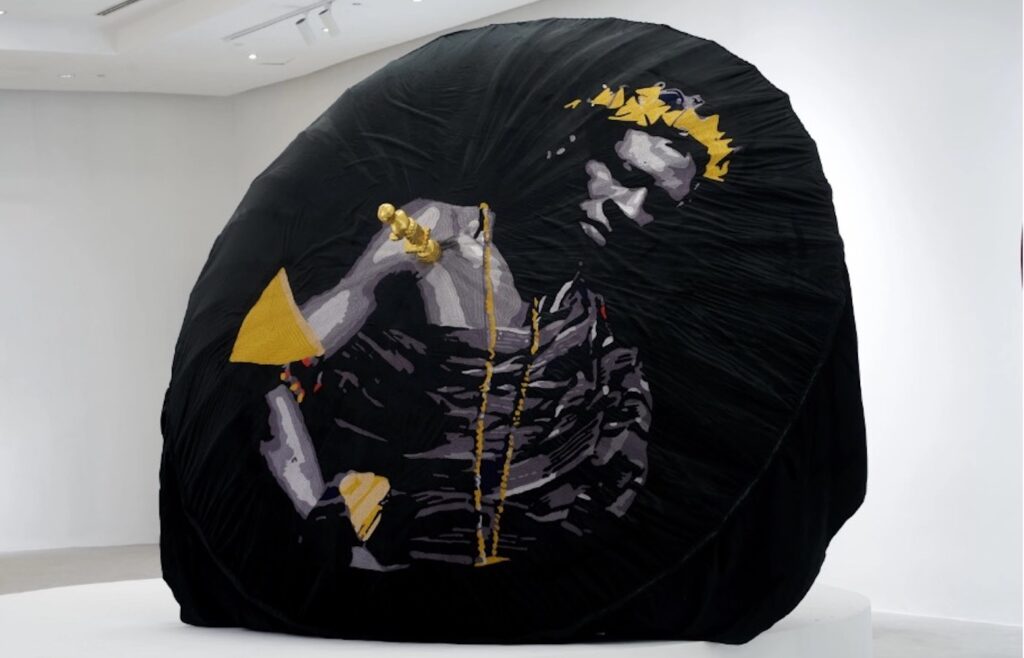Gallery 1957, Accra, Ghana
12 May 2023 - 17 Jun 2023

Rita Mawuena Benissan, In the World, not of the World, Installation View, 2023. Courtesy of Gallery 1957
Ceremonial umbrellas have been a documented part of Asante custom since at least the 18th century. As early as 1701, a Dutch emissary was versed enough in their importance to come bearing one as a gift on his first visit to the Asante king. A form of regalia reserved only for chiefs, they represented power, prestige and control. To sit beneath their shade was to display the qualities of coolness and inner spiritual peace, regarded as essential attributes for a ruler.
Today, they remain an integral, although largely overlooked, element of Ghanaian festivals, ceremonies and indeed, daily life. The ubiquity and invisibility of the umbrella is the start point for Rita Mawuena Benissan’s In the World, not of the World, a body of work that explores questions of culture, identity and history through the reimagining of customary objects. Consider for example, the extraordinary shot that takes place half a minute into the short film that Benissan has made to accompany her exhibition. A camera, aloft on a drone, flies over Makola market, the vast open-air shopping area in central Accra. From above we look down on dozens if not hundreds of umbrellas arrayed through the market. Here, the umbrella is stripped of its ceremonial role. Its task is simply to shelter market traders from the sun. Yet seen en masse from above, function gives way to form and the umbrellas are revealed as glorious signifiers of people and place. Their presence helping turn the hectic daily business of the market into what looks from a distance like a performance of sorts, a continuous and unified event often of surpassing beauty and rich cultural significance.
Traditionally, the fabric covering of a ceremonial umbrella is realised in coloured textiles such as damask or velvet, or in a woven cloth such as kente. With The Triumphant King Returns (2023), an artwork in the form of a large umbrella, Benissan reimagines this tradition. The work is made by the same artisans that ordinarily create chiefs’ umbrellas. But instead of a pattern its covering depicts an archive portrait of a Ghanaian chief dressed in traditional robes and heavily accessorised in gold. By crafting a work that’s part tapestry, part sculpture, Benissan reconfigures the role of the umbrella, turning it from an object symbolic of history and tradition to an item that, in itself, grapples with questions of memory and identity.
In parallel to making art, Benissan is the founder of Si Hene, a not-for-profit foundation dedicated to preserving the historical archives of the chieftaincy in Ghana and bringing awareness to the country’s cultural history. From referencing the Si Hene visual archive on Instagram we can recognise the figure in The Triumphant King Returns as Nana Kwaku Gyan, the twafohene (war chief) of Techiman, photographed in about 1970. But in transposing his image to an artwork Benissan chooses not to identify the chief by name or date. The same is true of many of the other men and women that she depicts on the large scale umbrellas and tapestries in the exhibition. It’s clear that their images are taken from photographs but it’s impossible to tell whether the source pictures are recent ones or decades old. This blurring of origins is surely significant. Benissan is not attempting to revisit the past so much as reframe it. Her concern is how objects like ceremonial umbrellas might still be able to speak with cultural relevance in the 21st century instead of being overlooked as historical artefacts.
-Extract from curatorial text by Ekow Eshu